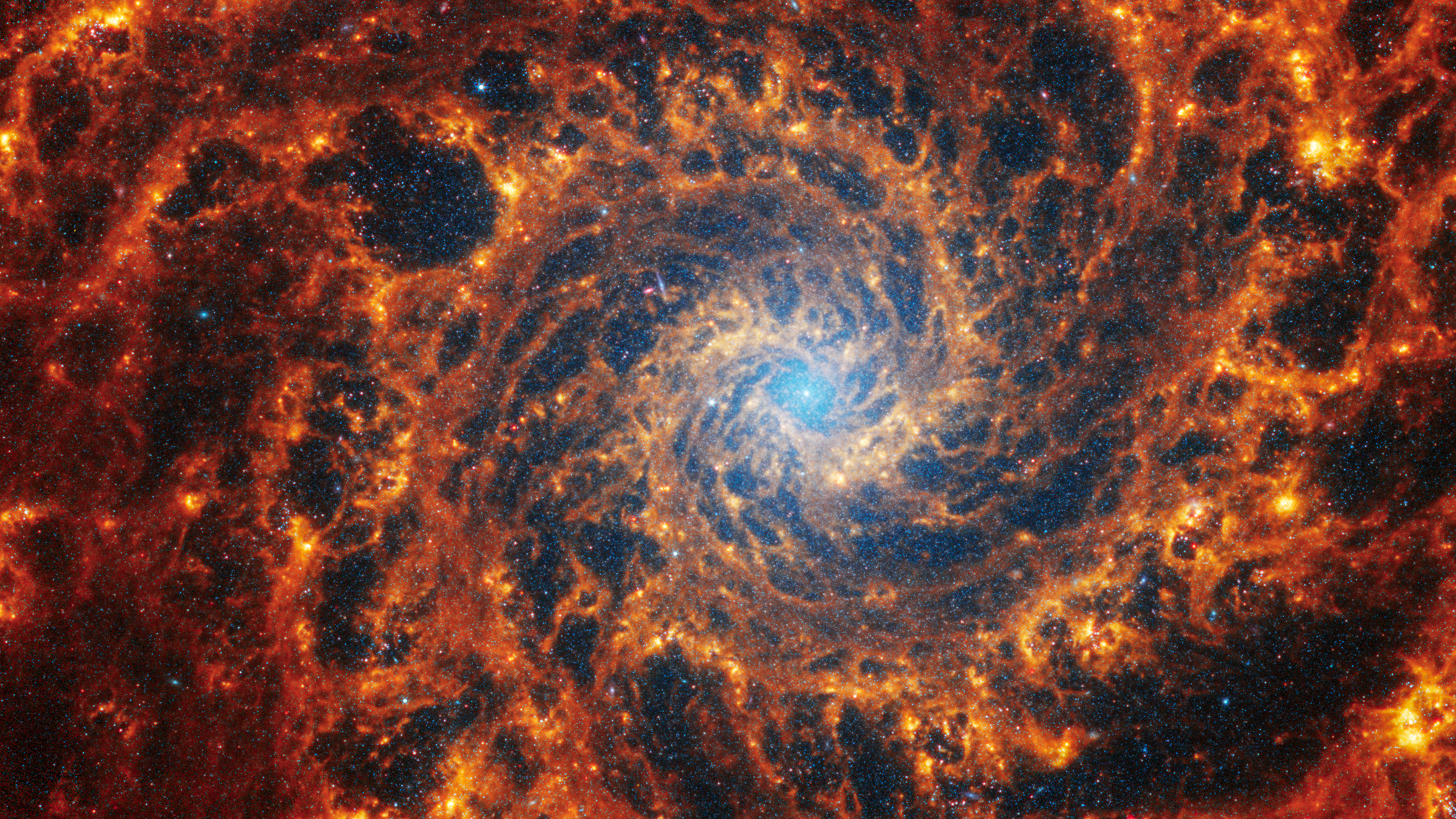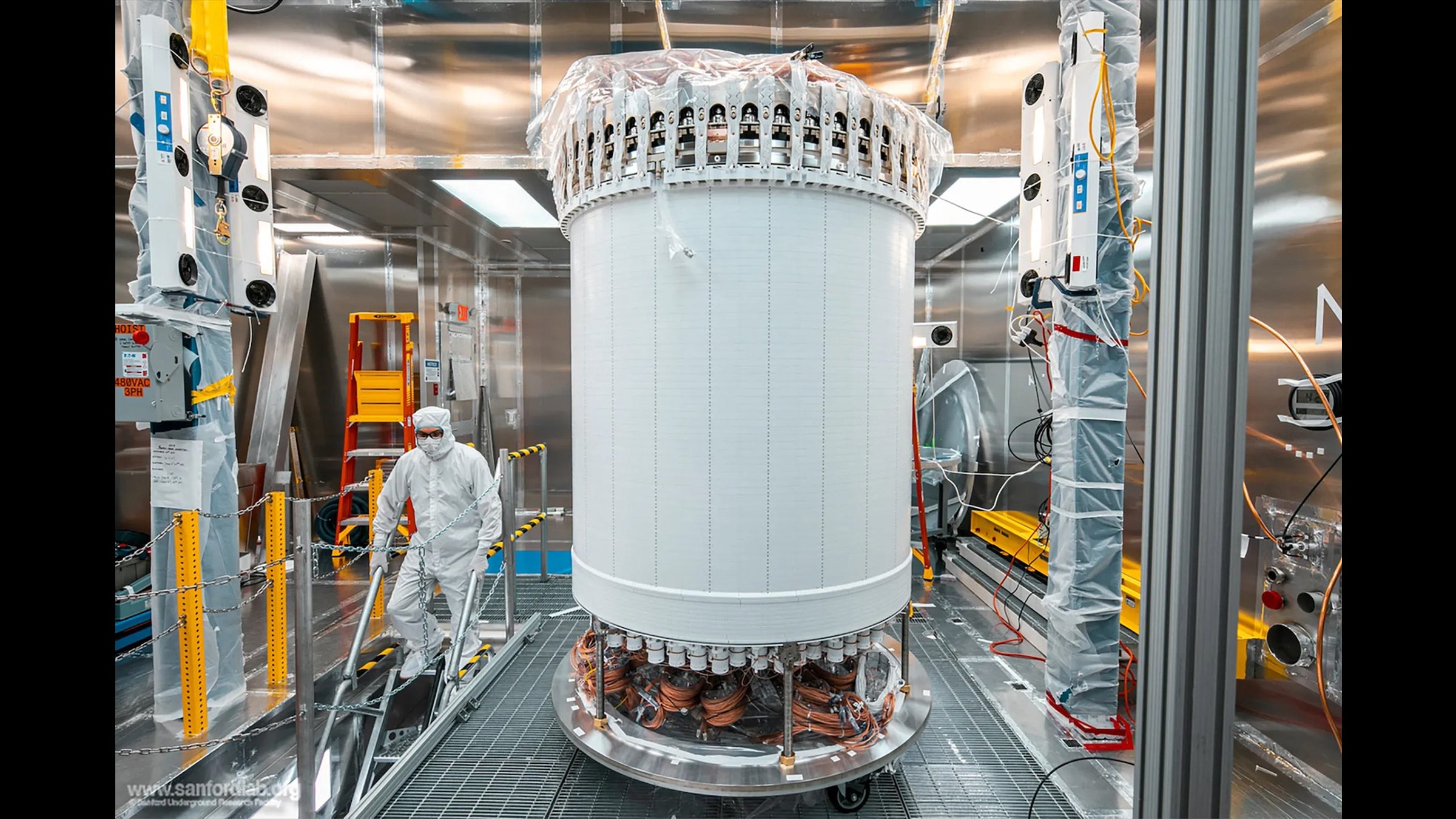Is Cosmology in Crisis?
A panel of physicists and astronomers grapple with possible cracks in our modern creation myth, the standard model of cosmology.

JWST’s image of spiral galaxy NGC 628, which is 32 million light-years away in the constellation Pisces. Credit: NASA, ESA, CSA, STScI, Janice Lee (STScI), Thomas Williams (Oxford), and the PHANGS team.
Over the past year and a half, data and images from the James Webb Space Telescope, or JWST, have been flooding in. And floating around in that sea of data (and from other instruments over the past 20 years) are at least three big problems: There appear to be too many big, bright galaxies, too soon after the Big Bang. No one can agree on how fast the universe is (or was) expanding. And we don’t know what most of the universe is made of.
The University of Texas at Austin brought together a panel of astronomy and physics faculty members to debate and discuss the meaning of these emerging problems in the data. The panelists were Kim Boddy, Mike Boylan-Kolchin, Karl Gebhardt, Can Kilic and Julian Muñoz. Have a listen and then decide: is cosmology really in crisis?
Show Notes
For a deeper dive into some of the issues raised in this episode, head over to this recently released video from the American Museum of Natural History’s Isaac Asimov Panel Debate, titled: “JWST’s Cosmic Revolution.” It features Mike Boylan-Kolchin, UT alum Neil DeGrasse Tyson and others.
Research related to today’s debate:
James Webb Space Telescope Images Challenge Theories of How Universe Evolved
Cosmic Dawn: The JWST is Changing our Calculus of the Cosmos
Hobby-Eberly Telescope Reveals Galaxy Gold Mine in First Large Survey
Did the James Webb telescope ‘break the universe’? Maybe not
Episode credits
Our theme music was composed by Charlie Harper
Other music for today’s show was produced by: Podington Bear
TRANSCRIPT
MA: I’m Marc Airhart. Over the past year and a half, data and images from the James Webb Space Telescope, or JWST, have been flooding in. And floating around in that sea of data are some problems. At least potentially that’s the case, when it comes to astrophysicists’ own guidestar, what’s known as the standard model of cosmology. That model helps predict what astronomers and physicists discover throughout the universe. But recently scientists have been a bit surprised.
MA: The University of Texas at Austin brought a panel of researchers together to debate and discuss the meaning of these emerging problems in the data. In today’s Point of Discovery, we recap highlights from that discussion.
MA: Surprise number one is this: There appear to be too many big, bright galaxies, too soon after the Big Bang. How did these monsters form so quickly? Mike Boylan-Kolchin, a UT professor of astronomy, elaborates.
MBK: Really, what’s sort of propelling this crisis potentially, is the fact that we are so data-rich now. … And so it’s only really in the context of having good data, can we say, “Do we have a good model?” And the data are now so good, that we can really make these predictions for how structure forms from the very earliest times, with its seeds at just 380,000 years after the Big Bang, and starts to grow and evolve into everything we see around us today. And those predictions are pretty much locked in by these observations at early times.
MA: He’s talking about data accumulated over the past 25 years, including recent stunning observations with the James Webb Space Telescope.
MBK: And what it’s seeing is … there’s a lot more starlight than we expected at those early times. And now, it’s a little complicated to interpret that light completely because we don’t have a full picture. But the best inferences that people have made tell us that some of these galaxies that are there at early times are actually bigger than is even theoretically possible in this standard cosmological model. So if this isn’t an error in the inference from the data, then this could be a real problem for the cosmological model.
MA: Karl Gebhardt, also a professor of astronomy, had a very different take.
KG: So I would say you started out and said, “We’re data rich.” I would say we’re actually quite data poor. And it’s a little bit of a “Cosmologists Gone Wild” situation, when you have only a few data points. A lot of people are making very strong claims … In terms of the early galaxies data that James Webb has been producing, right now we’re jumping on the few galaxies—[it] really is a handful of galaxies—that are a little bright. And I agree, it could be quite profound, but to have such a small number of objects, cause us to basically reinvent some of the fundamentals of how the universe came into being, and I would say, “Let’s wait a bit. It looks nice. … We definitely need more data early on and we definitely need more data between this very early time and this time today. …
MA: Surprise number two has to do with how fast the universe is expanding. Basically, if you measure the expansion rate at different times, with different methods, the results turn out to be different. No one can agree on the expansion rate of the universe. And this dilemma has been called the Hubble Tension. Kim Boddy, a physics faculty member, explained how scientists grapple with the problem this way …
KB: The Hubble Tension is … this idea that we have observations of the cosmic microwave background, so these are microwave radiation that’s coming … at us from all regions of space. And it tells us about this period of time that we’ve been talking about 380,000 years after the Big Bang. And so it’s our earliest direct window into the universe, right? And then we have observations that are much more recent in the sense that they’re closer. … It’s measurements of many, you know, supernovae, Cepheid stars, these sorts of astronomical objects that are all pieced together … to give an actual measurement.
MA: And those two types of expansion rate measurements—one based on the cosmic microwave background from very early times in the universe—and the other based on objects with known brightness from more recent times—just don’t add up. Julian Muñoz, an astronomy faculty member, weighed in on the disagreements …
JM: I would say that’s probably the biggest problem we have right now, even bigger than the JWST galaxies. …
MA: He noted that astronomer Edwin Hubble was the first to measure the expansion rate of the universe nearly a century ago. His measurements were of objects in relatively recent times. It’s only as we’ve been able to probe the very early universe—first with the Hubble Space Telescope and now with JWST—that the picture has gotten more complicated.
JM: Now, when you compare what Hubble was doing, essentially measuring near us how quickly the universe expands. And then using, you know, the early universe, this cosmic microwave background, these physics-rich, but very precise measurements, they disagree. And then, as a theorist, I get into these complicated feelings of you know, I want to believe the CMB, because it’s simple, I understand it. But you know, it disagrees with the direct astrophysical measurements.
MA: But Karl Gebhardt disagreed. According to him, the various measurements of the Hubble constant aren’t actually all that far apart.
KG: Thirty years ago, we had a famous astronomer here in the astronomy department, de Vaucouleurs, who argued very strongly it was 100—another famous astronomer out in California, Sandage, who argued very strongly, it was 50. And they would headbutt really hard at meetings. And so between 100 and 50, they would all say, “Yeah, this is like a 10 Sigma difference.” And … you know, “You don’t know what you’re talking about!” “You don’t know what you’re talking about!” And then Hubble Space Telescope was flown. And now we’re arguing now, instead of 100 and 50, we’re arguing between 72 and 67. And just to put that in context, and when I hear that, I just roll my eyes and say, Oh, come on, guys. Everybody.
MA: Julian Muñoz said the problem is bigger than the numbers alone might suggest.
JM: I want to actually also clarify for the audience, this 50 versus 100. They were people using broadly similar techniques. Now there's 67, 74—it's very different things. One of them comes from the microwave background, other one comes from the supernovae. These are very different. Like the fact that they disagreed to me is more significant than if it was different people analyzing the same data because then one of them at least is messing something up, right?
MA: Mike Boylan-Kolchin offered one more counterpoint…
MBK: And so the question is, will these initially small discrepancies stay there as discrepancies or will they go away? And so the longer a discrepancy stays there, even if it seems small, that means that it’s important, right?
MA: The third and final big area of uncertainty has to do with the composition of the universe. Dark energy and dark matter together make up the vast majority of our cosmos. We know they’re there. We know that they affect the shape and motion of galaxies, the accelerating expansion of the universe and more. But we can’t actually see dark matter or dark energy. We have no idea what they are.
MA: Can Kilic is a theorist and faculty member in physics, who’s been thinking about this. He likes to imagine the standard model of cosmology as a play. What makes this play hard to follow, though, is that two of the main characters—dark matter and dark energy—are hidden from the audience.
CK: We have three or four characters, and two of them are wrapped in, you know, … some sort of disguise that you can‘t … see through, right, so they’re just blobs. … and that was fine, right, with a certain amount of data, all we can do is, you come up with the simplest model that you can come up with that fits the data. And when our data had big error bars, we came up with two or three blobs, and that fitted everything great. But of course,we want to know what those blobs are… all this explosion of data, the Hubble Telescope, the JWST, all of that gets us to the point where this story no longer makes sense with a few blobs moving on the stage. You’re going to need to put faces to them and personalities to them.
MA: In the case of dark matter, physicists think there must be some kind of undiscovered particle out there—but the big problem is, they haven’t been able to detect it yet. And, as Karl Gebhardt points out, they’ve been trying for decades.
KG: And it just seems like we’re barking up the wrong tree. And I agree that the particle nature of dark matter works well. But there has been, you know, thousands of people trying to hone that argument. And it seems to fit. But we still can’t find it. It’s just …, something’s just not right, you know that.
MA: The leading contender for new particles that could fit the description of dark matter are called Weakly Interacting Massive Particles, or WIMPs. Kim Boddy said it’s time to broaden our search beyond WIMPs.
KB: There was a nice picture that we told ourselves about … these WIMPs ... And that kind of forced our field to put on blinders. … And we honed and honed and honed for, you know, decades on this.
MA: But now she said the pendulum is swinging the other direction. In recent years, there have been many new theoretical ideas about what dark matter could be.
KB: And I think that that has created a big boom, in terms of possibilities. … Now, it's sort of like, … where do we go? … How can we search this huge landscape of possibilities?
MA: Can Kilic pointed to the decades-long search for another fundamental building block of the universe—the Higgs Boson—as an example of how sometimes nature doesn’t reveal its secrets easily.
CK: And eventually in 2012, we found it only because thousands of people tried so hard. I mean, sometimes it’s just so hard that it takes thousands of people.
MA: So who knows, maybe eventually we’ll discover a particle that will bring the faceless blob of dark matter into sharp focus. But then there’s dark energy. Something seems to be pushing the universe to expand at a faster and faster rate. Theorists have said, well maybe there’s a kind of energy in empty space that pushes everything outward, called vacuum energy.
CK: Then the theorist goes to, you know, their blackboard or pen and paper and says, I know something about particle physics, which allows me to calculate this and they calculate it and the answer is incredibly wrong. It's wrong by, you know, different people count differently, but let's say a factor of 10 to the 100th.
MA: In other words, this vacuum energy should be so monstrously big that the universe just flies apart and stars and galaxies never form.
MBK: [laughs] It's basically impossible to be this wrong, you, it’s so hard to get off by this much; like, so hard, you would have to, it's …
KG: It's, it's the biggest error in the history of humanity.
MA: Karl Gebhardt leads the HETDEX project at McDonald Observatory which might help shed light on the nature of dark energy. The goal is to see how the expansion rate of the universe has changed over time.
KG: My take, when it comes to the expansion of the universe, is to completely ignore the theorists [laughs] … I’m hyper focused in the observational regime … we're almost done with an experiment that is trying to measure the expansion of the universe, as it was 11 billion years ago. So we're going to measure it there. There's a measure in the near time universe. And we're going to compare those two. And we'll be done in June. Very exciting.
MA: So will new data—from JWST or HETDEX or gravitational wave observatories like LIGO—wind up transforming our understanding of fundamental physics in the long run? Most of our panel were skeptical of big seismic shifts. But Boylan-Kolchin said this is a great time to be a scientist wrestling with big questions.
MBK: Weinberg famously said physics thrives on crisis, right? That’s sort of what propels things. … And so I think … it's a good thing, if there are these inconsistencies. Some of them will go away naturally, maybe they'll all go away, but maybe some of them will still be there and they'll be telling us something fundamentally about the universe.
MA: That’s our show. Point of Discovery is a production of The University of Texas at Austin’s College of Natural Sciences and is a part of the Texas Podcast Network. The opinions expressed in this podcast represent the views of the hosts and guests, and not of The University of Texas at Austin.
MA: For more on “cosmology in crisis,” head to pointofdiscovery.org, where we have links to research stories involving many of the people in today’s report. You’ll also find a link to a just-released video from the American Museum of Natural History’s Isaac Asimov Panel Debate, titled: “JWST’s Cosmic Revolution.” Mike Boylan-Kolchin, UT alum Neil DeGrasse Tyson and others used the 25th annual forum in March to dig deeper into some of what we covered in today’s podcast.
MA: If you like our show, be sure and tell your friends. We’re available wherever you get your podcasts.
MA: Special thanks today to our guests Kimberly Boddy, Mike Boylan-Kolchin, Karl Gebhardt, Can Kilic and Julian Muñoz. Our theme music was composed by Charlie Harper. Our senior producer is Christine Sinatra. I’m Marc Airhart. Thanks for listening.
About Point of Discovery
Point of Discovery is a production of the University of Texas at Austin's College of Natural Sciences and is a part of the Texas Podcast Network. The opinions expressed in this podcast represent the views of the hosts and guests, and not of The University of Texas at Austin. You can listen via Apple Podcasts, Spotify, RSS, Amazon Podcasts, and more. Questions or comments about this episode or our series in general? Email Marc Airhart.



